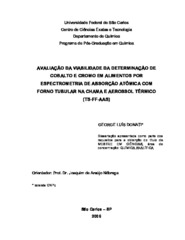Avaliação da viabilidade da determinação de cobalto e cromo em alimentos por espectrometria de absorção atômica com forno tubular na chama e aerossol térmico (TS-FF-AAS).
Abstract
In this work, a nickel tube used as atomization cell and a ceramic capillary for thermospray generation (TS-FF-AAS) were employed to increase the analytical performance of the flame atomic absorption spectrometry (FAAS). The
applicability of the method was evaluated for Co(II) and Cr(III) determination in food samples. Due to factors such as the low temperature into the atomization tube, the high atomization temperatures of the analytes, and the low levels of these elements in biological samples, a cloud point extraction (CPE) method was applied to both improve the processes of volatilization and atomization by formation of volatile metal complexes, and increase the sensitivity. Triton X-114 was used as surfactant to the implementation of the cloud point preconcentration procedure and, after the evaluation of several complexing agents, the best results were obtained with ammonium pyrrolidinedithiocarbamate (APDC). Parameters such as pH of complexation and concentrations of both surfactant and complexing agent were optimized. To improve the sensitivity, two configurations were evaluated to change the internal temperature of the atomization tube. The slotted tube, in which the internal temperature is higher due to more intense flame penetration, provided a significant increase in Cr(III) sensitivity. Parameters such as flame stoichiometry, atomization tube height, rich phase solvent, sample volume, carrier and flow rate were also evaluated. Limits of detection (LOD) of 2.1 and 2.5 µg L-1 and quantification (LOQ) of 7.0 and 8.4 µg L-1 (n = 10) for Co(II) and Cr(III), respectively, were obtained using optimized conditions. Intermediate precision (5.8 and 5.4 % for Co(II) and Cr(III), respectively), presented as relative standard deviation (RSD, %, 1s), were calculated from 10 consecutive readings of both analytes preconcentrated solutions. Interferences were observed in both volatilization and atomization processes into the atomization tube, as well as in the reactions of metal complexes formation due to both the complexity of the sample and the high concentrations of concomitants. A procedure based on extraction with 1 mol L-1 HCl was adopted for Co(II) determination. Only divalent species are quantitatively extracted. On the other hand, critical interferents, such as Fe(III) and Al(III), are not extracted. Procedures for interferents complexation with either fluorides or ethylenediaminetetraacetic acid (EDTA) were evaluated for Cr(III) determination. Method accuracy was checked by Co(II) determination in two certified reference materials (tomato leaves and bovine liver). There were no statistical differences between determined and certified values in a 95 % confidence level. The proposed method is efficient and allowed the determination of trace concentrations of Co(II) in foods without the need of sample digestion. However, the Cr(III) determination in foods was not possible due to the sample complexity and the interferences caused by concomitants in both preconcentration and determination steps.
